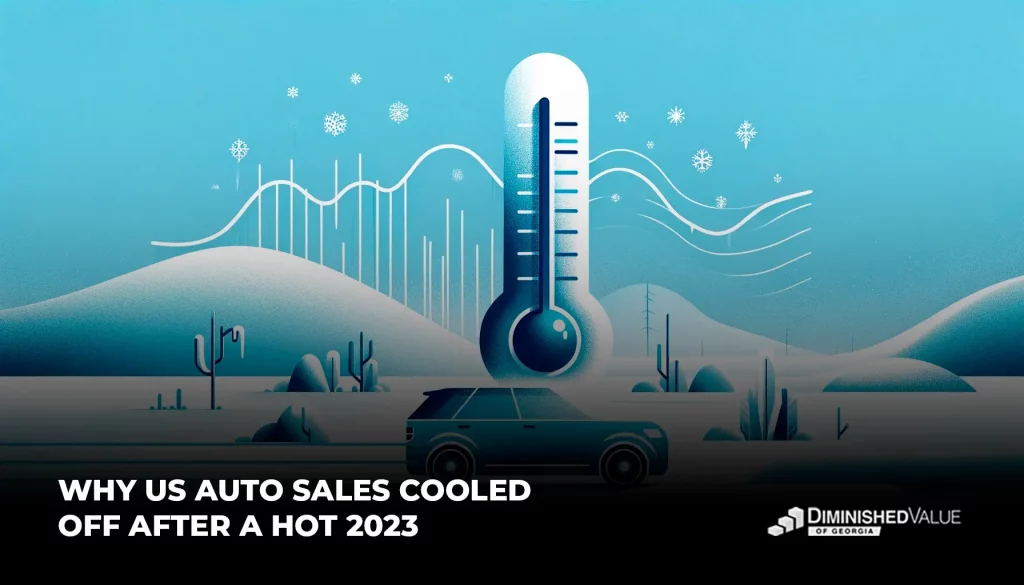As the festive fervor of 2023 faded into the rearview mirror, the U.S. light-vehicle market found itself navigating through a January chill. Despite a backdrop of improving inventory, enticing discounts, and robust fleet deliveries, the anticipated surge in sales cooled off, much like the winter air.
This period, usually quiet for new-vehicle sales, mirrored the broader economic challenges, setting a contemplative tone for the year ahead.

Why US Auto Sales Cooled Off After a Hot 2023 (PDF)
A Tale of Numbers and Expectations
January’s sales barely nudged, with a 0.1 percent increase to 1.06 million units, starkly underperforming against the 8 percent rise some optimists had forecasted.
GlobalData’s preliminary report highlights a significant drop in the daily selling rate and a SAAR that didn’t just fall short of expectations but marked the lowest January figure since 2012. This contraction signals a cautious consumer sentiment and a market recalibrating in response to broader economic pressures.
U.S. Light-Vehicle Sales January & YTD
| Jan. 2024 | Jan. 2023 | Jan. change | 1 mos 2024 | 1 mos 2023 | 1 mos change | |
|---|---|---|---|---|---|---|
| Ford | 144,895 | 139,262 | 4% | 144,895 | 139,262 | 4% |
| Lincoln | 6,985 | 5,808 | 20.3% | 6,985 | 5,808 | 20.3% |
| Ford Motor Co. | 151,880 | 145,070 | 4.7% | 151,880 | 145,070 | 4.7% |
| Acura | 8,636 | 9,488 | -9% | 8,636 | 9,488 | -9% |
| Honda | 84,574 | 75,026 | 12.7% | 84,574 | 75,026 | 12.7% |
| American Honda | 93,210 | 84,514 | 10.3% | 93,210 | 84,514 | 10.3% |
| Genesis | 4,269 | 3,905 | 9.3% | 4,269 | 3,905 | 9.3% |
| Hyundai brand | 47,543 | 52,001 | -8.6% | 47,543 | 52,001 | -8.6% |
| Hyundai Motor America | 51,812 | 55,906 | -7.3% | 51,812 | 55,906 | -7.3% |
| Kia America | 51,091 | 51,983 | -1.7% | 51,091 | 51,983 | -1.7% |
| Hyundai-Kia | 102,903 | 107,889 | -4.6% | 102,903 | 107,889 | -4.6% |
| Mazda N.A. | 30,279 | 22,967 | 31.8% | 30,279 | 22,967 | 31.8% |
| Subaru of America | 44,510 | 44,376 | 0.3% | 44,510 | 44,376 | 0.3% |
| Lexus | 22,512 | 20,439 | 10.1% | 22,512 | 20,439 | 10.1% |
| Toyota | 143,241 | 113,953 | 25.7% | 143,241 | 113,953 | 25.7% |
| Toyota Motor N.A. | 165,753 | 134,392 | 23.3% | 165,753 | 134,392 | 23.3% |
| Volvo Car USA* | 7,716 | 7,693 | 0.3% | 7,716 | 7,693 | 0.3% |
| Total 7 Reporting OEMs | 596,251 | 546,901 | 9% | 596,251 | 546,901 | 9% |
Highlights of Resilience and Recovery
Despite the overarching narrative of a market slowdown, stories of resilience shine through. Toyota and Honda’s impressive sales growth underscores a continuing recovery trajectory, with Ford, Subaru, and Mazda also enjoying upward trends.
This mixed bag of performance across different automakers paints a picture of a competitive landscape where brand strength and product offerings play pivotal roles in capturing consumer interest.
The Undercurrents of Change
Economic challenges and shifting interest rates have cast a long shadow over January’s sales figures, with Hyundai’s CEO, Randy Parker, pinpointing these as key obstacles.
Additionally, the narrative is complicated by significant weather events and evolving consumer preferences, particularly the cooling interest in electric vehicles (EVs) due to changing federal tax credits. Yet, amidst these challenges, fleet sales soared, marking a potential pivot point for the industry’s immediate future.
Adapting to Consumer Sensitivities
The industry’s response to a price-sensitive market is noteworthy. With increasing incentives and a rise in leasing options, automakers are actively drawing consumers back.
This strategic adjustment, aimed at counterbalancing higher interest rates and economic uncertainties, showcases the industry’s agility in responding to market dynamics.
Inventory and Incentives
As the industry steadies itself, inventory levels and incentives are being carefully managed to align with consumer demand.
The uptick in fleet sales, coupled with adjustments in vehicle pricing and incentive structures, reflects a strategic shift towards sustaining sales momentum while navigating economic headwinds.
Looking Ahead: Anticipating the Thaw
The beginning of the year has brought the automotive industry to a reflective pause, underscoring the need for a strategic pivot towards revitalization and adaptation.
With the electric vehicle sector at a significant turning point and brands recalibrating their market approaches, the emphasis is now on fostering innovation, enhancing direct engagement with consumers, and promoting flexibility in business strategies.
This period marks a crucial juncture for the industry as it seeks to address and overcome the hurdles of changing consumer interests and the broader economic scenario. The aim is to build a foundation of resilience and set in motion a resurgence that could redefine the automotive landscape in the year ahead.
In conclusion, January’s performance offers valuable insights into the challenges and opportunities facing the U.S. auto industry. As automakers navigate through 2024, the ability to adapt and innovate remains crucial.
The question that now looms large is whether these efforts will thaw the market’s current coolness, paving the way for a resurgence in consumer confidence and sales. Will the industry’s strategic adjustments turn the tide against economic and environmental headwinds?






